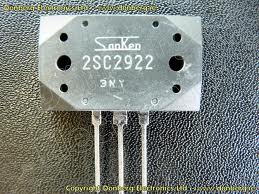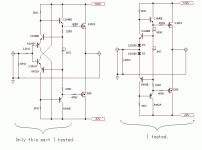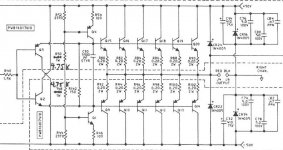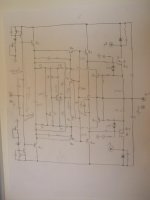Here is mine, I used it about 25 years ago as an output stage in hybrid amp. Actually, it is a complementary opamp with an unity gain. I used diodes D1 and D4 instead of transistors in diffpairs because no transistors can survive reverse BE voltage when output is shorted. I used it as a fast fix of a vacuum tube guitar amp (Hungarian BEAG) when no replacement output transformer was available (couple of such stages as a bridge to drive 32 Ohm speaker cab). The owner decided to leave it as is, with no output tubes. Probably, it was the first hybrid amp then, though not commercially available...
As drawn, it is class AB, for class A remove diodes D2 and D3 together with pots and resistors to ground.
Edit: transistors were KT814/KT815 and KT818/KT819.

As drawn, it is class AB, for class A remove diodes D2 and D3 together with pots and resistors to ground.
Edit: transistors were KT814/KT815 and KT818/KT819.

Hi
Though I don't test 95V supply....Sorry,
they are some bias for buffer circuit (not main loop feed back).
(It is not designed for 95V supply,so must replace other Tr.)
It's bias with local feedback.
If I test 95V supply , I may be try below ,
(because needs over 190V spec)
Power :2SJ201/2SK1530 200V/12A/150W
other all :2SA1406/2SC3600 200V/200mA//1.2W
if the supply is under 90V , I may try
:2SA1208/2SC2910 180V/70mA/0.9W
and resister 5K ohm is may be change (may be) 25K ohm.
OR chip amp LME49811,LME49830 ,not discrete
If I mistake ,I'm sorry very much ,please point out.
Regard
Though I don't test 95V supply....Sorry,
they are some bias for buffer circuit (not main loop feed back).
(It is not designed for 95V supply,so must replace other Tr.)
It's bias with local feedback.
If I test 95V supply , I may be try below ,
(because needs over 190V spec)
Power :2SJ201/2SK1530 200V/12A/150W
other all :2SA1406/2SC3600 200V/200mA//1.2W
if the supply is under 90V , I may try
:2SA1208/2SC2910 180V/70mA/0.9W
and resister 5K ohm is may be change (may be) 25K ohm.
OR chip amp LME49811,LME49830 ,not discrete
If I mistake ,I'm sorry very much ,please point out.
Regard
Attachments
forr said:"a HEC follower circuit"
Jan Didden's Pax amplifier output stage is a good candidate, more linear than a class A buffer, I think.
Hi
I have one I have been playing with, I will post a schematic sketch when I get home tomorrow evening.
Thanks Bra... What is Q1 & 4 doing?
CCS.
I was experimenting with a circuit intended to be exactly just a current follower. Using hexfets it is rugged as far as taking abuse and in temperature of operation. I burned my finger on the very undersized heat sink once and it just kept plugging along.
 That “no secondary breakdown” part.
That “no secondary breakdown” part.  I guess if you use a high output voltage than you might want to limit the bootstrap. The amount of compensation required depends a lot on your layout. For Q9 and Q10 I used KSC2690 & KSA1220. Q’s 3, 4, 7, & 8 are very fast devices and can be low voltage. (<20V) One thing I like is that with the error amp gate drive you can use small source resistors and still have good bias stability with better damping that comes with a lower output Z and larger bandwidth despite the higher transconductance of the fets. So the hexfet isn’t very linear.
I guess if you use a high output voltage than you might want to limit the bootstrap. The amount of compensation required depends a lot on your layout. For Q9 and Q10 I used KSC2690 & KSA1220. Q’s 3, 4, 7, & 8 are very fast devices and can be low voltage. (<20V) One thing I like is that with the error amp gate drive you can use small source resistors and still have good bias stability with better damping that comes with a lower output Z and larger bandwidth despite the higher transconductance of the fets. So the hexfet isn’t very linear.
Attachments
forr said:Hi CBS240,
---just a current follower---
You mean a voltage follower, a current follower is a completely different kind of beast.
Yes, a voltage follower. Current amplifier.
Anyone know of a simple enough circuit that acts as a power amp for a power amp? i.e. A load buffer (current dumper?)
i.e. What i want is a power amp that has 1x to 2x voltage gain that it accepts 10v to 80v inputs form other power amplifer and drives the load (basically acts as a load buffer for the signal amp)...
Any ideas?
Hi ! I found this very interesting and a little old thread
I was thinking to some of similar myself
My weird idea was to select using a high impedance headphone a high quality headphone amp that usually have a higher voltage gain, something like 6x.
And using this amp as a high gain preamp connect it to a power buffer without voltage gain or gain 2x to drive a pair of efficient speakers.
I would do this because I read somewhere that the VAS gives a strong print to the overall sound and so the final amp should have the same sound, more or less
Also the possibility to carry out the selection of the headphone amp with a headphone should make the selection easier I think
The power buffer that I like best by instinct is the diamond buffer
Regards,
gino
Last edited:
Good evening 
Have you built your power buffer in the end ? I am interested
In general I do not understand why they fixed the sensitivity of power amps around 1V when a good preamp easily output 10 V with low noise and minimal distortion
Moreover the preamp stages usually are powered by regulated voltage rails while the power amp rails are not regulated normally
I would leave to the power buffer only the dirty work, so to speak
Regards,
gino
Have you built your power buffer in the end ? I am interested
In general I do not understand why they fixed the sensitivity of power amps around 1V when a good preamp easily output 10 V with low noise and minimal distortion
Moreover the preamp stages usually are powered by regulated voltage rails while the power amp rails are not regulated normally
I would leave to the power buffer only the dirty work, so to speak
Regards,
gino
Hi there Gino:
Short Answer no... I never did. We had to move and all my equipment/ parts/ gear had to be packed up and most of it is still in boxes... and I picked up another hobby in the mean time. (Photography)... which is just as expensive and time consuming... but it is fun to revisit old things again.
My motivations to do this were several. but the similarity to yours is, that we can use an amplifier that sounds good to our ears, but cannot drive hungry loads on it's own...
Short Answer no... I never did. We had to move and all my equipment/ parts/ gear had to be packed up and most of it is still in boxes... and I picked up another hobby in the mean time. (Photography)... which is just as expensive and time consuming... but it is fun to revisit old things again.
My motivations to do this were several. but the similarity to yours is, that we can use an amplifier that sounds good to our ears, but cannot drive hungry loads on it's own...
Thank you for the kind answer
I have become a little obsessed with the preamp selection
To find a nice sounding solid state line preamp seems very difficult
And tube preamp have usually too high gain
Instead there are people who swear about the excellent sound quality of some headphone amps
I will search again but power buffers are quite rare actually
Kind regards,
gino
I have become a little obsessed with the preamp selection
To find a nice sounding solid state line preamp seems very difficult
And tube preamp have usually too high gain
Instead there are people who swear about the excellent sound quality of some headphone amps
I will search again but power buffers are quite rare actually
Kind regards,
gino
Here something quite opposite I experienced 20 years ago... I had build a Mj15003/4 based 200wattt power amp with cascode front end (classic 80's design). it did not need a strong pre-amp to get to full power on it's +/- 68v rails... but for some reason a friend of mine borrowed my pre amp... so i hooked a crappy 20 watt integrated amp (i think it was an extensively repaired quasi -complementary Kenwood KA-3700) as a pre-amp, taking the speak taps of the Kenwood to drive the power amp.... I expected some noise and distortion.... but I was absolutely floored as I raised the volume.... the sound was so full, with mid bloom and midrange body that I have "never" experienced with any pre-amp since then.... I often wondered why this would be so.... and I was not running the Kenwood more than a couple of volts inot the power amp... I still remember the sound and the clarity I got in the 200Hz to 1kHz range. The highs were not so clear... but the mid-bloom was amazing.
Thank you very much again
I thought a lot about this issue because often I read of people using preamps with too much voltage gain and unable to set rightly the volume
And of course there is the other way, more easy and common I guess
Instead of looking for a very unusual power buffer use a buffer preamp
Much more common solution
By the way I have a huge admiration of the diamond buffer topology (I have seen it in some very well received amps)
A four bjts schematic with a superb couple of these at the output

If the resulting power is little I can always use high efficiency speakers
Thanks and regards,
gino
I thought a lot about this issue because often I read of people using preamps with too much voltage gain and unable to set rightly the volume
And of course there is the other way, more easy and common I guess
Instead of looking for a very unusual power buffer use a buffer preamp
Much more common solution
By the way I have a huge admiration of the diamond buffer topology (I have seen it in some very well received amps)
A four bjts schematic with a superb couple of these at the output

If the resulting power is little I can always use high efficiency speakers
Thanks and regards,
gino
- Status
- This old topic is closed. If you want to reopen this topic, contact a moderator using the "Report Post" button.
- Home
- Amplifiers
- Solid State
- Buffer Power amp.


